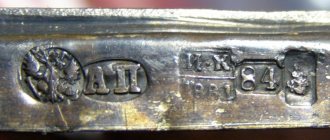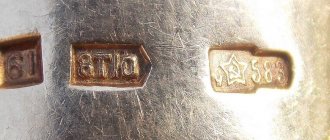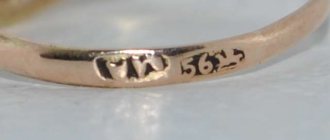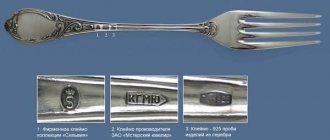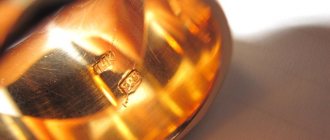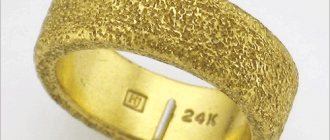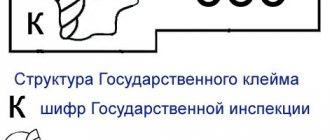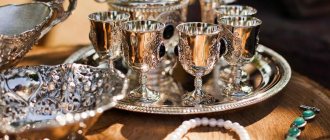USSR silver samples, all sample numbers
The Soviet government cared little about hallmarking silver, since the priority goal was to audit precious items and subsequently sell them to other countries, since it was necessary to raise funds for the world revolution. The first actions regarding the normalization of processes in the jewelry business were made a year after the revolution, when control over all processes was entrusted to a commission that was formed under the Council of People's Commissars.
Almost ten years later, silver hallmarking was carried out according to the rules that were introduced under Tsarist Russia. The document was published at the end of the nineteenth century. The purity of silver was determined by the presence of a mark. which looked like a woman's head in a kokoshnik, which is enclosed in shields of various shapes. The shapes were round, rectangular, oval or hammer-shaped. Next to the image was a number indicating the sample, and the initials of the heads of the assay districts were also indicated. In 1908, the marking was changed, and the female profile began to be turned to the right side, and the district was designated in Greek letters.
These marks continued to be used at enterprises that opened after the revolution. In 1918, a platinum plant began operating in the capital, which was created on the basis of the factory named after. Khlebnikov. He was engaged in the production of products intended for enterprises in the chemical and electrical industries, and also dealt in small batches of silver cutlery, namely spoons, forks and cup holders. These products were marked with the “Platinopribor” mark.
In the twenties of the last century, jewelry was made in artisanal jewelry workshops. Their number increased greatly, and the People's Commissariat for Finance allowed the free sale of jewelry. As a result, in 1923, the Moscow Jewelry Partnership was created, which was supposed to control the production and sale of gold and silver items. As a result, for three years all jewelry products were labeled “MYT”.
At the end of the revolution, only three assay offices operated for a long time, which were located in the capital, St. Petersburg and Kostroma, but since 1924 there were already fourteen of them. Precious materials were already weighed and began to be counted in metric units, and silver samples no longer had double digits. but three-digit.
In 1927, a new branding system was adopted, which continued to operate for thirteen years. All silver items had to correspond to the official hallmarks and be marked with the hallmark of the assay office. The authenticity of the products was confirmed by a relief or linear image of a worker holding a hammer on his shoulder. The organization code was also added to this picture, and each of them was distinguished by a separately assigned Greek letter, which could periodically be replaced by a symbol with various combinations.
Since 1936, an All-Union Office was created to regulate the sales and production of precious items, which became the legal successor of Mostorg. A jewelry factory was created in the capitals of each republic, which was supposed to mark its products with a special mark. They acted in the same way in artels and industrial plants, which were actively opened in the thirties of the last century.
Since 1953, the last digits of the year of manufacture of products began to be added to the mark. For example, “TZ0” meant that the item was made by representatives of the Tallinn Jewelry Factory in 1960. If the letters at the enterprises were identical, then the hallmark inspection codes were examined to determine the place of production.
HYZ today.
Nowadays, HYUZ specializes in the production of 925 silver products, of which there are more than 3,000 items. The range is constantly enriched and expanded with new types of products. Various techniques are used in production: silver is combined with blackening, enamel of different colors is applied, gilding, natural and synthetic stones, etc. are used.
The plant pays great attention to the quality of the silver from which its products are made. The metal that goes into production meets the requirements of the international standard ISO 9001-2001. HYUZ is equipped with the most modern equipment. The assortment of the Kharkov Jewelry Factory includes jewelry, silverware, and souvenirs.
The factory produces silverware, which is considered the crown of jewelry art. These are a variety of glasses, mugs, glasses, flasks, coffee and tea sets, cognac and wine sets, and silverware. All these products will serve as decoration for the holiday table, and they can also be an excellent gift. And silver figurines will fit well into the interior of any home.
Many organizations have a tradition of awarding commemorative silver and gold medals to their best employees. They also give badges with the company logo, sculptures, cups, and souvenirs. All this can be ordered from Kharkov Jewelry Factory CJSC. The order will be made according to your sketch or they will create a sketch themselves, taking into account your wishes. The manufacturer guarantees high quality for each piece of jewelry.
The official website of the company » published by BoBaH | | publish your brand
| Tweet |
<< previous brandnext brand >>
Hallmarks on silver after 1958
Since June 1958, the branding system has been revised again. The design became in the form of a hammer and sickle, which was placed inside a five-pointed star. Until 1965, it was convex, and then it became mortise, because this mark could be renewed after the item had been used for a long time. The codes of assay organizations were designated in Russian letters and were sometimes written as strokes and dots in special combinations that were understood only by specialists on this issue.
The main features of the Soviet mark:
- the Cyrillic letter denoting the assay office;
- a convex or flat star with a hammer and sickle;
- sample number;
- rectangular shield with oval edges.
Since 1969, the last digit of the year has been moved to the beginning of the sign. For example, combinations from the “3LU” category appeared, which meant that the product was produced at a jewelry factory in Leningrad in 1973. At the same time, the Moscow Mint stamped “MMD”, and if the item was restored, then the letter “R” was added to it "
Since the second half of the seventies, the Soviet jewelry industry already had many large enterprises that used modern equipment. Factories began to produce a variety of silver goods, including jewelry, dishes, souvenirs, and precious stones. To develop and modernize production, the Soyuzyuvelirprom association was created. However, this unification did not affect the principles of silver hallmarking, because the system did not change until 1994.
Names and letter designations of jewelry (code)
Bracelets B , BR ; Brooches BR , BS , B ; Vases B ; VL plugs ; Decanters G ; Clamps 3 ; Cufflinks ZP ; ZN icons ; KL necklace ; Rings K ; KB Cups ; KN pendants ; Spoons L ; Spatulas for cakes LP ; Medallions M ; Thimbles N ; Leaf cutter knives NL ; Knives NZh ; Necklaces O ; Ashtrays P , PP ; Cup holders PD ; Egg coasters PYA ; Cigarette cases PR ; Powder compacts PDN ; Sockets P ; RM glasses ; Sugar bowls CX ; Earrings C ; Salt shakers SL ; Stacks ST ; Chains C ; Cups H ; Teapots CHN ; Sugar tongs Shch .
Structure of the hallmark
The structure of the hallmark, established since 1994 in Russia for products made of precious metals.
Source
What does sample mean?
Fineness is the main characteristic for each precious metal. In their pure form, these metals are soft and malleable and unsuitable for jewelry. Therefore, precious metals contain a variety of elements, and all the numbers on the sample indicate the content of precious metal in a given alloy. For example, let’s try to figure out what the 875 hallmark means. The answer is extremely simple - this product contains 87.5% silver.
For silver, the following numerical indicators are used: 800, 830, 875, 925, 960. The exception is the 999 sample, which also indicates the almost complete absence of other impurities. So we got the answer to this fairly common question: “875 standard: what kind of metal is this?”
History of the testing system
In jewelry, various assay systems are used; the measurement gives an idea of the gold content in a specified unit of the alloy.
Metric system
Metric quality standards, as the most accurate system, are used in most countries of the world, including Russia. The sample shows the amount of precious metal in 1000 units of the alloy. In pure gold without additives there are 1000 metric units, the highest standard is 999.9, the mark on a gold product can be a number up to 999.9 depending on the content of the noble metal in the alloy.
Carat sample system
In the USA, Switzerland and a number of other European countries, the British carat system is used, the unit of which corresponds to 1/24 of the mass of the alloy. 24 carat gold means a 100% pure substance without inclusions, which in fact does not occur. 22 carats indicates 22 parts of precious metal in the total mass of the sample. To convert from metric measurements to the carat system, the data is multiplied by 0.024.
Lot testing system
In the Middle Ages, lot measurement was used by the peoples of Western Europe and Scandinavia. In ancient times, to determine the mass of the precious metal, stamps consisting of 16 lots were taken. This sample indicates the number of lots of gold in a unit of the alloy grade.
Spool sampling system
In the Russian Empire, from the beginning of the 18th century, a spool measure was used for silver alloys. It is based on the Russian pound containing 96 spools. This sample expresses the weight of the precious metal in 96 alloy units. In 1733, the spool system was introduced for gold; accordingly, the 96th sample indicated a pure substance without additives. The spool measure worked until 1927, after the USSR switched to metric measurement, identical to the German sample system.
When thinking about what type of gold products are most popular in Russia, you should consider the following points:
- 375th - is a low-grade alloy containing 38% precious metal and alloy in the form of silver, copper and other impurities. Characterized by a yellow or reddish color that fades over time;
- 500th - indicates the presence of 50.5% precious metal with an admixture of silver and copper;
- 585th - the alloy contains 58.5% precious metal with an alloy of silver, copper, palladium and nickel. It is considered the most popular option in jewelry production due to the excellent characteristics of the material. The presence of a hallmark certifying 585 gold standard indicates the appropriate quality of the product;
- 750th - an alloy from bright yellow and greenish to pink and reddish in color contains 75.5% gold with admixtures of silver, palladium, platinum, copper, nickel. The high-grade mixture is in demand in the jewelry industry and is used for high-precision work;
- 900th – used for minting coins;
- 958th - rarely used due to the softness of the structure, susceptibility to deformation and inexpressiveness of shade. The material is mainly used in the production of works of art.
585 gold ring
Principles of branding
The mark was applied inside or outside the product. The most popular method of applying it is mechanical. This art is a classic for jewelry workshops. Initially, hammers were used to apply it, but later a special mechanism was created for automatic branding. Special anvils were also created that made it possible to apply jewelry stamps as accurately as possible. The machines were introduced after the need for mass branding arose.
The electric spark method is carried out with the participation of electrodes. For this purpose, a special installation was made, with the help of which the print is burned out with a spark. If the brand has jumpers at the top between the outline and the badge, it means that this item was branded using the electric spark method. This method is more effective, but not all jewelry workshops and factories use it, because such an installation costs a lot of money.
For very expensive jewelry, a special laser can be used, which applies the mark very carefully. This method is not as relevant in mass production because the laser mark disappears over time. If a person has purchased such a product, then he needs to treat it more carefully, because after a while the mark will simply disappear, and it will no longer be possible to confirm that the jewelry belongs to a precious alloy.
How to distinguish the authenticity of a stamp?
Knowing what the quality mark of the alloy looks like on Soviet or Tsarist gold, it is easy to distinguish the authenticity of the mark on the jewelry that was inherited. They often fall for the tricks of scammers when purchasing jewelry second-hand, when they offer a fake with gold plating under the guise of high-grade metal.
In order not to make a mistake when choosing a product in a jewelry store, you should carefully examine the print with a magnifying glass. A counterfeit stamp, and therefore the low quality of the precious metal, is evidenced by blurred images, uneven inscriptions, improper appearance and incorrect placement of the print.
Quality and tradition. History of the Kharkov Jewelry Factory
Products from the Kharkov Jewelry Factory - both vintage and modern - are found quite often and always attract attention. Such earrings, rings, brooches, or pendants are always distinguished by their impeccable design and very good jewelry work.
Kharkov Jewelry Factory is an old manufacturer with a history of more than 80 years.
Its history began in 1929. Before this, a state watch workshop had already operated in Kharkov, which had grown several years before the watch factory. Initially, only watch products were produced there, but by the end of the 1930s it was decided to produce jewelry from production waste (silver, gold). The very first products were simple bracelets - like those that complement watches, as well as simple women's jewelry without jewelry inserts. They were loved by consumers for their high quality and versatility, and even enjoyed success in Moscow - at Soyuzuvelirtorg.
Soon, a workshop for the production of jewelry was organized at the watch factory. After the war, from 1947, watchmaking faded into the background and jewelry manufacturing became a priority. A few years later, watch production was completely liquidated, and the factory was repurposed only for the production of jewelry.
Almost immediately, the factory took part in the All-Union Jewelry Exhibition in Moscow and received high praise from critics for its high quality and excellent jewelry work, especially in the manufacture of rings. Jewelry from the 1950s to the 1970s is also distinguished by its high artistic and design quality.
The items of the Kharkov Jewelry Factory are not inferior to world brands and have a fairly diverse assortment. Classic products and jewelry in ethnic style using natural cabochon-cut inserts are presented. There are also evening jewelry with pronounced Art Nouveau and Art Deco features with large and bright faceted inserts. Alexandrites, rock crystal, corundum, and jewelry glass were used for them.
At the beginning of 1973, a new era began for the factory - production was now renamed to its modern name - Kharkov Jewelry Factory. From this moment on, the scale gradually increases, the range of products grows, and talented jewelry artists are involved in the work. The variety of designs and jewelry rates is also increasing.
Many of the jewelry we knew from childhood and loved were produced by the Kharkov Jewelry Factory. There are many classic models for this manufacturer: treasured raspberry earrings, rings with large pink corundums, brooches with ornamental stones and natural quartz - rock crystal, citrine, etc. Similar jewelry can be found in the modern assortment of HYUZ.


